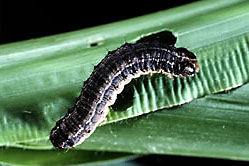Mir1 Gene Stalls Corn Pests
|
|
To pupate from caterpillars into adult moths, fall armyworms and southwestern corn borers must go on a 10- to 20-day feeding binge. Their fare is the stalks, leaves, husks, and ears of corn plants. Unchecked, they can cause losses of 30-plus percent.
But now scientists may have a way to turn the tables on the pests: genetically engineer the plants so they churn out a rare natural enzyme that curbs the caterpillars' destructive appetite—so much so, they'd grow to less than half their normal size and weight.
"The idea is to reduce their ability to chew up the plant and to slow their reproduction," explains Dawn S. Luthe, a Mississippi State University (MSU) molecular plant biologist.
Except for so-called tropical corn, domestic hybrids generally lack the genetic muscle to withstand the pests on their own. Thus the need for insecticide, especially for sweet corn production, notes Luthe’s colleague, W. Paul Williams. He is a plant geneticist in the ARS Corn Host Plant Resistance Research Unit at MSU, near Starkville.
Weekly insecticide applications can help ensure worm-free ears, he says. But timing when to spray can be a costly, hit-or-miss proposition.
Intrigued by the prospect of a natural alternative, the researchers pushed their early investigations of the enzyme further—with help from other researchers and graduate students.
In recent lab studies they used molecular techniques such as PCR (polymerase chain reaction) and RFLP (restriction fragment length polymorphism) to trace the enzyme to an elusive gene, Mir1. Until then, this gene had only been found in callus tissue cultures from two corn germplasm lines, Mp 704 and Mp 708, that were developed at Mississippi State.
In spring of 1996, ARS and MSU applied for a patent on the Mir1 gene and its enzyme, 33 kd cysteine proteinase. Now Luthe says, “We’re in the process of negotiating an option agreement with DeKalb Genetics to explore commercial potential.” The agreement would allow the company to insert the gene into greenhouse plants and regenerate them to study Mir1’s insecticidal properties.
The scientists envision their new found enzyme would serve as a built-in caterpillar deterrent in corn and maybe even cotton. "If this is something that proves to be worthwhile, it could be possible to increase the plant's concentration of the enzyme," says Williams.
That would ensure a caterpillar ingests a high enough dose that it either stops feeding or doesn’t cause further serious harm. Lab and field studies suggest this could mean fewer than 50 percent of the pests survive to adulthood.
On another front, the Mir1 gene’s enzyme could replace or prolong the effectiveness of toxin-making genes from the bacterium Bacillus thuringiensis.
Bt’s genes now protect commercial lines of bioengineered corn and cotton from boll worms, tobacco budworms, and other caterpillar pests. But concern that pests are genetically adapting to tolerate Bt’s toxins has fueled a search for alternatives and counter strategies. Among these is gene-stacking, or putting more than one resistance gene into a plant.
“It’s possible that if you could combine these different genes,” says Williams, “you could slow development of resistance in the insects.”
So how long until new, worm-resistant corn hits the farm field? Possibly 2 or 3 years—if ongoing research and commercial interest hold course. "It's only going to come if we can provide the gene and associated technology to the seed companies," Williams says. They would "move this from research into reality." -- By Jan Suszkiw, ARS.
W. Paul Williams is in the USDA-ARS Corn Host Plant Resistance Research Unit, Room 340, Dorman Hall - Stone Blvd., Mississippi State, MS, 39762; phone (662) 325-2735.







